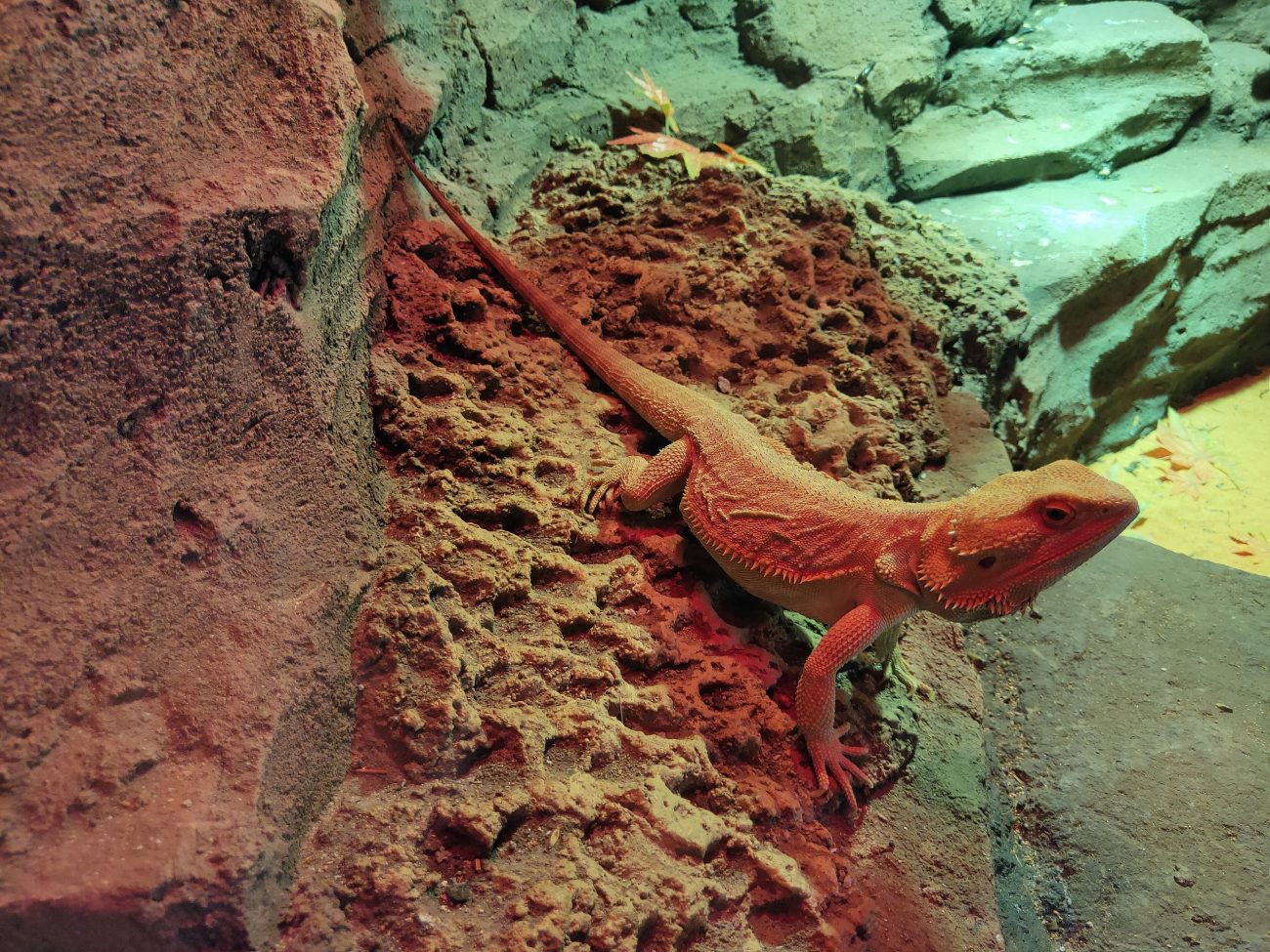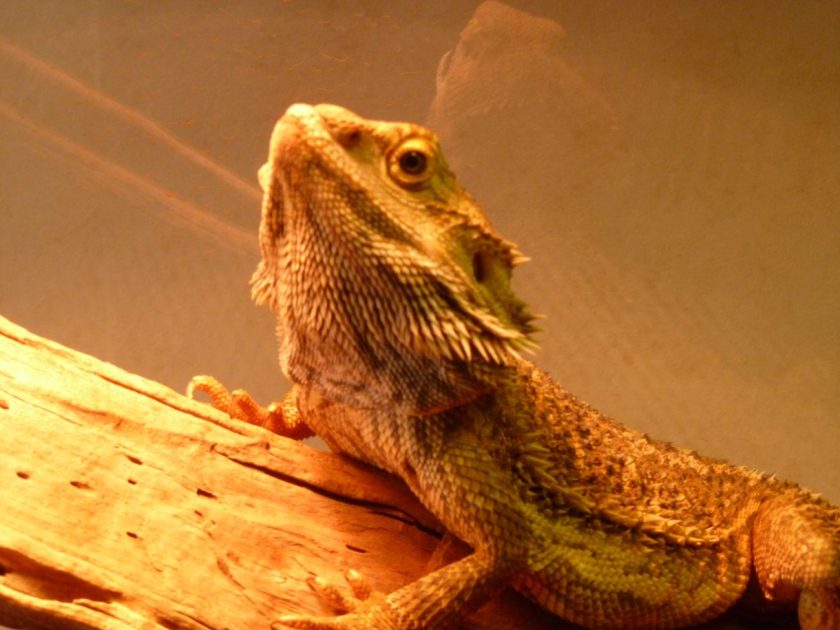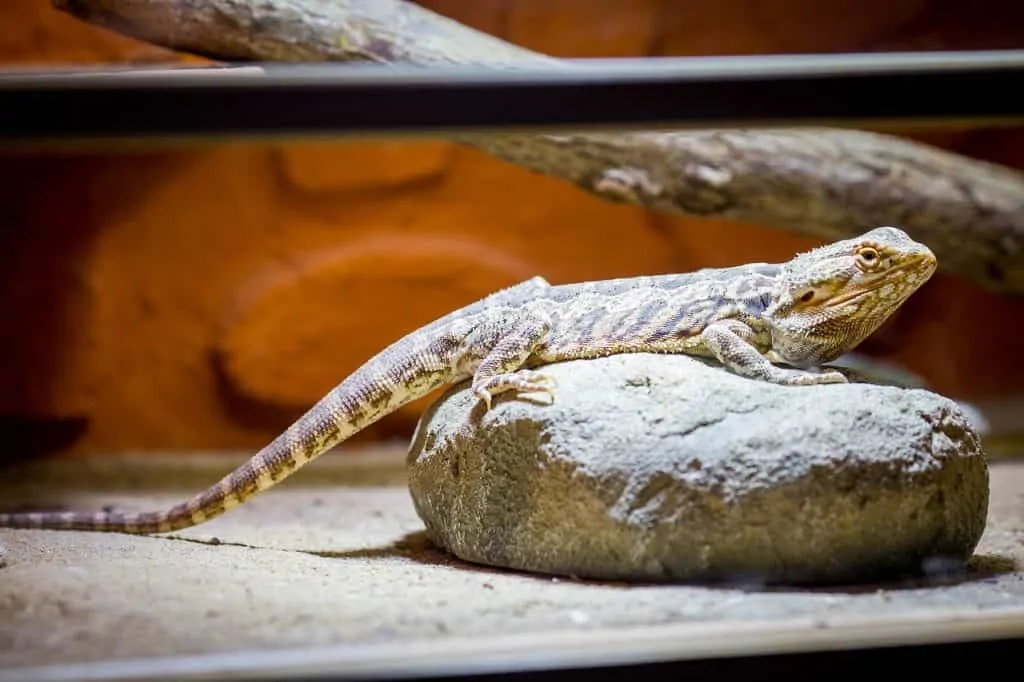Bearded dragons are well-known agamid lizards from the harsh Australian outback. They are used to getting sunlight, and plenty of it. Conveniently, the desert sun’s rays provide them with plenty of ultraviolet light (UV), which enables their metabolisms to function.
In this article, you’ll discover why UV light is critical to bearded dragon captive care and what bulbs and fixtures best simulate the natural UV spectrum in a vivarium setting.
Before we dive into detail, I’ll give you a quick list of bearded dragon ultraviolet facts. I don’t want to sound fanatical, but if you want a healthy beardie, you should accept these with religious fervor – because it can mean a difference between life and death for your pet.
Quick facts about UV lights for Bearded Dragons
- You must have a UVB or UVA/UVB lamp in your bearded dragon tank.
- Bearded dragons that don’t have proper UV lighting risk serious health issues like Metabolic Bone Disease and, ultimately, death.
- You can’t substitute UVB lights with dietary supplements.
- Replace the UV bulb every 6-12 months because its function diminishes.
- The UVA/UVB or UVB lamp should have a T5 or T8 mark, 10.0 strength, at least 10% UVA/B emission, and reach 60 to 80% of the tank; because of the last fact, linear bulbs work best.
- The stand-alone UV lamp is ideally mounted inside the tank within a specialized fixture with a reflector.
- Always get a bulb or a lighting setup from a reputable producer.
Best UV Lights Roundup
Getting a UV lamp of murky origins can be dangerous for your pet or at least annoying (due to unreliable output).
To help you make the right choice, here is a short list of tried-and-tested UV lights from manufacturers with decades of experience.
1. Arcadia ProT5 UVB Kit

The fixture is designed for 2-foot-long tanks. It is 24-inch long and comes equipped with a 24-watt, 16mm diameter, 22.5-inch T5 High Output linear bulb (12% UVB and 30% UVA), a highly reflective removable reflector, a power cable, and montage hardware for easy installation. It also includes a free link cable that lets you daisy chain the fixture with up to nine other ProT5 or Jungle Dawn LED Bars.
Speaking of compatibility, the fixture is compatible exclusively with T5 HO tubes and is not to be used with standard fluorescent tubes.
The bulb provides an optimal balance of UVA and UVB for high-need reptiles, plus excellent color rendition.
Like other Arcadia products, the fixture is made in Germany and uses high-quality electronics, securing a maximum UV bulb lifespan of 12 months.
🦎 Find Arcadia ProT5 UVB Kit – 12% UVB Desert, 24-Inch (Bulb & Fixture) on Amazon
2. Arcadia 14% UVB T5 Bulb – Dragon Lamp – 22-Inch

Also manufactured in Germany, this 22.5-inch, 16mm diameter, 24-watt T5 High Output bulb is specially made for full sun baskers like bearded dragons. It offers increased visible light when compared to other models, as well as a balanced UV spectrum – 14% UVB and 30% UVA.
Also, don’t worry about flickering lights because this bulb ensures a steady glow, plus it provides an excellent color rendition to show your beardie in its best light.
Arcadia 14% Dragon Lamp also has an excellent lifespan of 12 months, guaranteeing long-lasting performance.
🦎Find Arcadia 14% UVB T5 Bulb – Dragon Lamp – 22-Inch on Amazon
3. Zoo Med ReptiSun 10.0 UVB T5(HO) 22-inch Fluorescent Tube
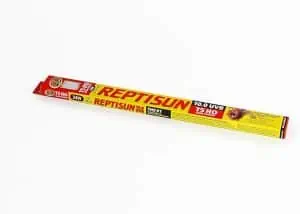
Although it is a weaker tube than the previous two recommendations, it is still sufficient for full sun baskers, especially because it is a T5 High Output type. Just make sure you install it at the right height – 10-12 inches or exactly according to instructions from the manufacturer. Your beardie should never be closer to the bulb than 10 inches.
The tube is compatible with Carolina Custom Cages fixtures such as Standard Fixture and reflector, the Fixture and reflector with Undermount Assembly, and the Fixture and reflector with Basking Light Assembly.
🦎Find Zoo Med ReptiSun 10.0 UVB T5(HO) 22-inch Fluorescent Tube on Amazon
4. Mega-Ray Mercury Vapor Bulb (100 Watts – 120V)
If you’re still keen on getting a Mercury Vapor bulb after the research, look no further than the Mega-Ray’s 100 Watts (120V) Mercury Vapor Bulb.
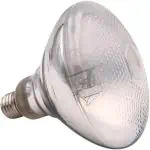
For security and optimal UVB exposure, ensure a minimum distance of 12 inches away from your lizard. The properly adjusted bulb at 12 inches will produce approximately 150-200 microwatts per cm2 of UVB and 900-1200 uW/cm2 of UVA. If you want a bit more distance, the maximum setting of 20 inches yields 50-70 uW/cm2 of UVB.
This is an ideal solution to make your out-of-the-tank beardie hangout spot warm and safe (Vitamin D3-wise)
🦎Find Mega-Ray Mercury Vapor Bulb – 100 Watts (120V) on Amazon
5. Zoo Med PowerSun H.I.D Metal Halide UVB Lamp & Lamp Fixture
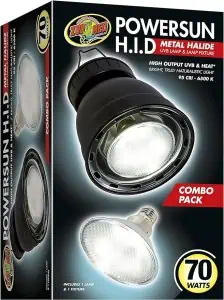
This combo features a powerful 70-watt Metal Halide UVB Lamp paired with a purpose-built Lamp Fixture, with a ceramic socket and integrated ballast for optimal performance.
What sets this setup apart is the Zoo Med’s unique lamp construction, which creates a true flood-lamp effect. Importantly, the producer claims design eliminates the tricky “UV hotspots” that are known to be hazardous with other metal halide lamps, ensuring a uniformly lit and safe environment. The fixture consists of a highly polished reflective dome, which, besides providing top functionality, looks really cool.
🦎Find Zoo Med PowerSun H.I.D Metal Halide UVB Lamp & Lamp Fixture on Amazon
What Are UV Rays and UV Lights?
We must first understand the UV spectrum to understand your bearded dragon’s UV needs truly.
The central system hot star we affectionately call the Sun constantly bombards the Earth with electromagnetic radiation. We call it sunlight, mostly for the visible part of the electromagnetic spectrum. However, other “light” or rays exist within the Sun’s energy beam package, too.
- The radio waves
- The microwaves
- The infrared light (IR, heat)
- The visible light (“white light”)
- The ultraviolet light (UV)
- The X-rays
- The gamma rays
The difference between these light segments is their wavelength, measured in nanometers.
In the context of keeping reptiles, the most important parts of the spectrum are the infrared (heat), the visible light (daylight), and the ultraviolet waves (UV).
UVA, UVB & UVC Difference
Now, let me introduce you to the family of ultraviolet waves.
Ultraviolet light is the invisible part of the spectrum for humans, but it is extremely important for us and all other life on Earth. UV light also has its categories – and you might recognize the aberrations from the reptile lighting equipment – the UVA, the UVB, and the UVC.
UVA and UVB are what we want to provide in our reptile tanks.
1. UVA
UVA is considered optional, but it is said to boost reptile’s mood, appetite, and natural behavior in general. Thus, most UVB bulbs these days also emit UVA and are full-spectrum.
2. UVB
UVB part of the spectrum is essential for animal health. Too much can be dangerous (luckily, most UVB is reflected by our atmosphere) – hence the sunburns and skin cancer risk.
However, when an appropriate amount of UVBs land on the reptile skin (human, too!), they work some metabolic magic. They trigger the body into synthesizing Vitamin D3 (which is not a vitamin but a hormone-like substance), which is required for calcium absorption and use.
Vitamin D3 plays a crucial role in the proper functioning of many organs and organ systems – nervous, cardiovascular, skeletal (bone density), and digestive.
On top of that, healthy UVB exposure boosts hormone production, stimulates the immune system, and leads to better skin pigmentation.
3. UVC
Unlike our previous “ultraviolet,” UVC rays are the bad guys. They destroy DNA upon contact because they have the highest energy of all ultraviolets. Fortunately, the atmosphere filters out all of the UVC – otherwise, all life on Earth would be effectively irradiated to death.
Still, because our civilization likes to utilize death rays whenever possible, UVC lamps are used in laboratories, water systems, air purifiers, and other environments we want to sterilize.
If it needs to be more obvious, never get a UVC UV lamp for your tank – but there’s a minuscule chance you would, anyway.
However, the main reason for mentioning them is to raise awareness that certain cheap UV lights from unreliable or unknown producers can accidentally emit UVC. Exposure can have devastating consequences for your reptiles – from blindness to cancer. Thus, when choosing bulbs, stick with reliable, tried-and-tested reptile brands.
Why Does Your Bearded Dragon Need UV Light?
Beardies are naturally found in the Australian Outback and are diurnal (day) lizards. That means they spend the entire day under the desert Aussie Sun – and crikey, that’s some bright sunshine!
Dr Gary Ferguson has categorized beardies as one of the reptile species with the highest UV needs. Along with other desert species, they belong in Ferguson Zone 4. The “mid-day open sun baskers” prefer an average UV Index of 2.6-3.5 and a maximum UVI of 4.5 – 9.5 in the basking zone.
Thus, bearded dragons often need the mightiest reptile UV lamps available. In the reptile hobby, 4.5-6 UVI is what we strive for in the terrarium’s basking zone.
What Happens if I Don’t Get a UVB Lamp For My Bearded Dragon?
Without enough UVB light, your bearded dragon will fail to thrive. His body won’t work properly, and he would likely get the dreaded Metabolic Bone Disease (MBD).
MBD is a disease where the whole skeleton softens and degenerates, leaving the reptile in pain and unable to move or feed. The only way to prevent MBD is to provide your high-need beardie with enough Vitamin D3 – and you do that by installing a UV lamp. You could say that UVA/UVB tube is a real-life lightsaber against MBD and other reptile illnesses.
Because juvenile bearded dragons grow so fast, they have high calcium and UV needs to develop healthy bones. If you have a baby beardie, ensure your UV bulb is high-quality and brand new. That goes for all age groups, of course, but for young beardies, it can mean a difference between life and death.
What Type of UV Light is Best for Bearded Dragons?
There are several types of UV bulbs and lamps in the reptile market.
- Linear fluorescent UV(B) bulbs
- Compact or coil fluorescent UV(B) bulbs
- Mercury Vapor bulbs
- Metal halide bulbs
Not all are equally suitable or convenient for bearded dragons.
Linear Fluorescent UV Bulbs
Linear fluorescent bulbs are the most popular UV bulbs in the hobby, and for strong reasons. They provide the highest and most stable UV output, cover enough tank surface due to their shape, and are free of many problems related to coil UV fluorescents and mercury vapor bulbs.
Installation-wise, linear bulbs are always nestled in a specialized reflective fixture in tune with the bulb’s power and size. The fixture ensures the bulb has the best possible output and lifespan.
Depending on their diameter and power, there are two kinds of Fluorescent UV bulbs – T8 and T5 (HO). T8 bulbs are an older technology that produces less powerful UVB output, while T5 HO (‘High Output’) are more potent.
You can use any of them; with proper installation, a T8 will still do its job despite the limitations. However, it is important to follow instructions.
Which is better, T5 or T8 UVB for Bearded Dragons?
T5 bulbs are a more effective choice than T8s. They are a newer line of UV bulbs that produce stronger UVB and last longer, around 12 months before.
However, in line with their abilities, they are the pricier of the two (but still worth it).
As said, T8 lights are inferior to T5 because they are an older line of bulbs with less powerful UVB emission and a shorter lifespan. You have to replace a T8 UV bulb every six months. Also, T8 cannot be installed outside of the tank – the inner side, under the lid fixture, is a must for them to be effective. Still, if installed and treated correctly, most quality T8 bulbs, even for needy bearded dragons, will do the job.
Compact Fluorescents
I’ll say it immediately – compact or coil fluorescents are not a good choice for most bearded dragon enclosures.
As mentioned, the UV light must cover at least 2/3 of the tank. Contrastingly, the compact bulbs cover only a small part of the tank – essentially, only the basking spot. This may be a good option for species with lower UV requirements but not for bearded dragons.
The only scenario where the compact or coil UV bulbs can deliver enough light is in small enclosures – less than 20” tall and 24” wide. For better efficiency, they should always be used with a reflective fixture.
Mercury Vapor & Metal Halide Bulbs
At first glance, Mercury vapor and Metal halide bulbs look like everything you were looking for in a bulb. They provide heat, daylight, and full-spectrum UV as an all-in-one solution.
However, things are not as great as they seem at first. First and foremost, they have the same issue as compact bulbs – they can’t offer enough UV coverage. Secondly, their UV output is less stable than with fluorescents, degrading quickly. Thirdly, these bulbs provide lots of heat, which could be controlled with a dimmer. However, when you dim the bulb’s output, you also dim the already-flimsy UV.
However, experienced beardie owners suggest that mercury vapor and metal halide bulbs are excellent as portable, out-of-enclosure hotspots. If you’re letting your beardie run around a lot or have a special spot for him outside the tank, a mercury vapor lamp or a metal halide can provide heat and UV.
Is Basking Light UVA or UVB?
When people say “basking light,” they often refer to lighting that provides warmth and light. However, UVA and UVB are necessary to the “basking spectrum.”
Using a full spectrum UV bulb daily and a daylight/heat bulb is the right combination for creating a true “basking light” for beardies.
What is the Best UV Wattage for a Bearded Dragon?
Unlike most other lights, Wattage (the W number) is not critical for UV bulbs. Other numbers are what counts.
First of all, the percentage of UV output is the crucial factor. For beardies,10% – 14% UV output is needed to satisfy their needs.
Do Bearded Dragons Need UV Light 24/7?
No, bearded dragons don’t need their UV light on 24/7 – in fact, it would be harmful to their well-being.
Like all creatures, bearded dragons need to sleep. That means you should provide them with a proper day-night cycle – 14 hours of “sunlight” during the summertime, 12 hours in spring and autumn, and 10 hours during winter. For the rest of the time, beardies should enjoy darkness and a slight temperature drop down to 70 degrees F (or 20 Celsius).
I recommend using a trustworthy automatic timer to control the lights. Otherwise, it’s too easy to forget to turn the lights on and off at the right time.
Where in My Vivarium Should I Put My UV Light?
The UV bulb should be mounted inside the enclosure in a specialized reflective case. It should be under the mesh, screen top, or any other lid, even if transparent. Only the strongest tubes (e.g., 14%) can be mounted above the screen top.
Direct in-tank placement is because most screens & mesh tops block at least some of the UVB rays emitted by the lamp, while glass and plastic tops block them entirely. Only the T5 HO UV bulbs of sufficient strength could be mounted outside the mesh or screen top – but you would have to check the UV level.
Of course, when mounting the bulb, you’ll ensure a safe distance depending on the bulb’s strength. A 10-24 inch range is the standard – but even the weakest bulbs shouldn’t be less than 10 inches away from your beardie.
Knowing the Exact UV Light Output
You can confirm that enough UVB reaches the basking spot using a reptile-friendly UV index meter, such as Solarmeter. These devices measure the UV Index (UVI) over the selected spot. The UVI of the bearded dragon’s basking area should be 4.0-6.0.
Now, about finding the perfect height. If the Solarimeter is too expensive, Arcadia has provided this neat visual guide to correctly place their UV bulbs for full-sun baskers such as beardies.
For example, to get the desirable 4-6 UVI at the basking spot, you need to place their most powerful linear bulb – 14% T5 45-60 cm (18-24 in.) from the tank floor. On the other hand, you would place the 10% T8 UVB at 25-30 cm (10-12 in.).
Take Care!
I hope the sometimes-complex topic of bearded-dragon-friendly UV lights is all illuminated for you.
I know they may seem too complicated and expensive, but my final (and repeating) advice is never to try and save money on proven UV bulbs and fixtures from reputable producers.
Unfortunately, failing to provide quality UV lighting is much more expensive in the long run because it can be deadly for your beardie. I promise – quality UV light is one of those bearded dragon care essentials that will make your reptile hobbyist life easier and brighter in the long run.
Do you have a question or anything to add? Drop a comment below, and our experts will join the conversation ASAP!

